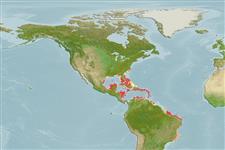Teleostei (teleosts) >
Acropomatiformes (Oceanic basses) >
Pempheridae (Sweepers)
Etymology: Pempheris: Greek, pempheris = the name of a fish (Ref. 45335).
Eponymy: Sir Robert Hermann Schomburgk (1804–1865) was a German businessman who was asked to supervise transporting Saxon sheep to Virginia, USA (1828), where he stayed. [...] (Ref. 128868), visit book page.
More on authors: Müller & Troschel.
Environment: milieu / climate zone / depth range / distribution range
Ecology
Marine; reef-associated; depth range 3 - 30 m (Ref. 9710). Tropical
Western Atlantic: southeastern Florida, USA and Bahamas to Brazil.
Size / Weight / Age
Maturity: Lm ? range ? - ? cm
Max length : 15.0 cm TL male/unsexed; (Ref. 26340)
Dorsal spines (total): 5; Dorsal soft rays (total): 8 - 9; Anal spines: 3; Anal soft rays: 32 - 34. Ventral profile deeply curved in front of anal fin, tapering upward to slender caudal peduncle. Mouth very oblique (Ref. 26938). Scales ctenoid along the back posterior to dorsal fin and ventrally on head and body, otherwise cycloid, coppery with a dark band at base of anal fin; young nearly transparent, silvery over abdomen (Ref. 13442).
Occurs in clear water with coral bottom. Form aggregations in dark crevices and caves (Ref. 9710). Nocturnal (Ref. 9626). Its name probably refers to the juveniles, which are so transparent that the backbone can be seen in the living fish (Ref. 26938). Feeds on zooplankton, particularly the larval stages of invertebrates (Ref. 13442).
Life cycle and mating behavior
Maturity | Reproduction | Spawning | Eggs | Fecundity | Larvae
Robins, C.R. and G.C. Ray, 1986. A field guide to Atlantic coast fishes of North America. Houghton Mifflin Company, Boston, U.S.A. 354 p. (Ref. 7251)
IUCN Red List Status (Ref. 130435: Version 2024-1)
Threat to humans
Harmless
Human uses
Fisheries: of potential interest; aquarium: potential
Tools
Special reports
Download XML
Internet sources
Estimates based on models
Preferred temperature (Ref.
123201): 25 - 28.1, mean 27.4 °C (based on 656 cells).
Phylogenetic diversity index (Ref.
82804): PD
50 = 0.5000 [Uniqueness, from 0.5 = low to 2.0 = high].
Bayesian length-weight: a=0.01445 (0.00738 - 0.02832), b=2.97 (2.80 - 3.14), in cm total length, based on LWR estimates for this species & Genus-body shape (Ref.
93245).
Trophic level (Ref.
69278): 3.1 ±0.0 se; based on diet studies.
Resilience (Ref.
120179): High, minimum population doubling time less than 15 months (Preliminary K or Fecundity.).
Fishing Vulnerability (Ref.
59153): Low vulnerability (10 of 100).
Nutrients (Ref.
124155): Calcium = 92.8 [48.0, 143.0] mg/100g; Iron = 0.717 [0.438, 1.149] mg/100g; Protein = 18.5 [17.3, 19.5] %; Omega3 = 0.115 [0.072, 0.181] g/100g; Selenium = 26.2 [15.2, 47.3] μg/100g; VitaminA = 73.7 [22.3, 236.3] μg/100g; Zinc = 1.47 [1.01, 2.09] mg/100g (wet weight);
